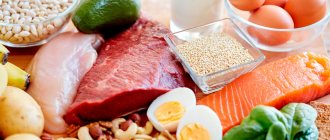Regular gym sessions with a trainer, proper nutrition and proper rest are the basis for quickly gaining muscle mass. These criteria consist of many subtleties and nuances that need to be known and regularly applied in practice.
If your cherished goal is to build sculpted muscles, then it will be useful for you to get acquainted with our material. A well-designed action plan is the basis of any successful business. We have drawn up such a plan for you and invite you to get acquainted with it.
Practice small steps - change gradually
You should not strive for quick and dramatic changes. Our body is a delicate instrument and must be handled with care. Maybe someone practices sports to the point of exhaustion and other methods of “shock therapy,” but we suggest going a different way.
Set yourself up to slowly but surely achieve your goal. Gradually switch to a new diet and eating style. If something goes wrong and you see that the fat layer is increasing instead of muscles, reconsider the quality of food you eat.
Seek advice from a trainer. He will select the training regimen that suits you and the optimal physical activity. Do not expose your body to stress and sudden changes. This can ruin all your efforts.
What factors contribute to muscle growth?
Researchers have suggested that muscle growth, or muscle hypertrophy, occurs through three main mechanisms.
The first is mechanical tension, which is resistance applied to the muscle.
The second mechanism is metabolic stress, which is associated with the accumulation of metabolites. Metabolic stress results from the muscle's production and use of the energy needed to contract. Its manifestation is a burning sensation in the muscles.
The third mechanism is muscle damage, which manifests itself as muscle pain. Pain is caused by muscle damage caused by exercise.1
When developing a training plan whose primary goal is muscle hypertrophy, the best results will come from an approach in which all movements, rep and set patterns, time under tension, etc., are designed with these three main muscle growth factors in mind.
Of course, muscle growth is influenced not only by what we do during planned exercises. Proper nutrition, sleep and stress management also play an important role in achieving results.
Keep a food diary
Keeping such a diary is useful not only for those who want to lose weight. If you are trying to gain mass, it will become a powerful tool for self-control and motivation. It needs to be done regularly, recording even the smallest snacks. This is the only way to see objectively what you are saturating yourself with. And this is the only way to quickly react to such undesirable moments as the appearance of excess fat.
If you feel a layer of fat, look in your diary and determine how you can adjust your diet.
Practice frequent and high-calorie meals
You need to build the right eating regimen. It should be regular and frequent - approximately every 3 hours.
You should not skip meals, otherwise the effect of the steroid hormone cortisol intensifies in the body. It has a destructive effect, depleting muscle tissue, and can nullify all your efforts.
It is important not only the quantity of products, but also their quality and calorie content. The main principle when gaining weight is to consume more calories than you expend. Properly selected foods are rich in nutrients, contain protein and slow carbohydrates.
Traditionally, the list of recommended products includes:
- eggs;
- meat (turkey, chicken, beef);
- fish;
- cottage cheese;
- cereals (rice, buckwheat, oatmeal);
- nuts;
- dried fruits.
Make sure that the level of proteins in foods is always stable, and fats and carbohydrates can be reduced if necessary.
Increase your portions
During the rapid muscle building phase, nutrition plays a key role. If this is exactly the task you are facing now, then you need to increase the amount of food. Multiply your usual portion by approximately two times.
The size of portions can be adjusted depending on the increase in muscle mass - normally it should be 3 kg per month. If the result is higher, it means that the fat layer is also growing.
Increasing portions does not only apply to solid foods, this also applies to protein shakes. They can be prepared from the following ingredients:
- milk;
- bananas;
- cottage cheese;
- honey;
- peanut butter;
- fruits;
- yoghurts.
If there is a feeling that the body cannot cope with a large portion of food, then it is better to use a fractional intake. To do this, divide the portion into two parts and eat them after a certain period of time.
How Much Muscle Can You Gain... REALLY?
Year after year, thousands of smart people around the world never stop discussing how quickly and how many kilos you can actually gain. More than one study has been conducted on this topic.
Based on all this, over the course of your entire life you will be able to approximately gain the following amount of muscle mass (without resorting to medications):
- Average for men: about 18-22 kilograms of muscle over a lifetime;
- Average for women: about 9-12 kilograms of muscle over a lifetime.
Please note that in this case we are talking exclusively about muscles and not about weight. Of course, you can gain much more weight than muscle.
Also keep in mind that these are averages. There are always exceptions to any rule, who either cannot reach even the lower limit of the average, or easily exceed all the upper limits. This is influenced by a number of factors, so the indicators for each person will be different (we will talk about these factors a little later).
But for most people, most of the time... this is the maximum amount of muscle mass you can gain in your lifetime.
Keep up with your cardio
Excessive cardio exercise inhibits the growth of muscle fibers. But it is not recommended to completely exclude them from the set of recruitment activities. They are useful because they speed up metabolic processes, prevent obesity, and stimulate appetite. Since the caloric content of food intake increases during the gaining stage, you need to maintain a balance of incoming calories and cardio training.
The optimal option is three cardio per week in the form of 15 or 20 minutes of running, jumping rope or aerobics. Fitness club cards will give you unlimited access to the gym, where you can work out at a time convenient for you, either with a personal trainer or on your own.
Take gainers after workouts
High-calorie nutritional supplements with proteins and carbohydrates significantly enhance the effect of training. The intake of protein and amino acid complexes is included in all programs to increase muscle volume.
You should drink such cocktails after each workout, about half an hour after you have worked out in the gym. Gainers speed up recovery and do not allow the body to compensate for expended energy at the expense of muscles.
However, gainers can be consumed two hours before visiting the gym, if it is not possible to take other food. Exercising on an empty stomach is ineffective - the body will lack energy and will begin to take it from the muscles. This can lead to an undesirable effect such as weight loss. As a result, the lesson will be in vain.
How to gain weight by working out at the gym
How to gain weight at home can be clear even to a person who does not have deep knowledge of physiology, sports and proper nutrition. To achieve good results in gaining “quality” mass in the gym, you must follow the basic recommendations of professionals.
They are as follows:
- minimize the load on the cardiovascular system (despite the objective benefits of cardio training for the human body, frequent performance of such exercises burns a large number of calories necessary for weight gain);
- focus on strength exercises using sports equipment (the base not only promotes muscle growth, but also creates relief for a man’s entire body);
- do the minimum number of repetitions using the maximum weight within one approach;
- before and after strength training, take special supplements that help increase the effectiveness of the exercise (it is recommended to drink a pre-workout complex 30 minutes before training, and afterward drink a protein shake to provide the body with enough protein).
Do basic exercises
Intense physical activity helps build new muscle fibers. You need to exercise regularly, and this is where a gym membership will come in very handy. Specialists will develop a program for you that will give the most optimal result for working out the body and increasing muscle mass.
This program is based on basic exercises. With them, recruitment happens faster, and the result is more stable. Without gaining enough volume to begin with, that is, without creating a foundation, it will be difficult to work on individual groups to give them a beautiful relief.
Basic exercises for men:
- promote comprehensive muscle development;
- accelerate metabolic processes, increase performance;
- allow you to systematically increase the load and weights;
- increase the production of growth hormone, testosterone, endorphins.
Include squats, bench press, and deadlift in every workout. Squats form muscle volume, increase leg strength, and increase the concentration of anabolic hormones and growth hormone. Deadlift increases endurance, strengthens the back, and develops coordination. This is one of the best exercises for growing and strengthening muscles. The bench press will help pump up your shoulders, increase the volume of your biceps and triceps, and build your pectoralis major and latissimus dorsi muscles.
These are not all the advantages of the basic complex. Overall, it causes a hormonal surge in the body and is ideal for gradually but surely building muscle.
Work in the gym can be supplemented with home exercises, for example, pull-ups on the horizontal bar. The complex of all these sporting events will allow you to develop a base. Based on this, you can already begin isolating exercises to work specific muscle groups.
What affects the rate of weight gain
How many kg of muscle you can gain over a certain period of time is influenced by at least 4 factors, without taking into account which it will be difficult to achieve any significant result.
Genetics
This is an area that we cannot change. But knowing and understanding your genetic characteristics will help you soberly assess your capabilities and create a training program that will help you achieve the best results. From a weight gain perspective, important innate characteristics include physiological striated muscle fiber area, fat distribution, hormone levels, body type, joint structure, and digestive system function.
You can evaluate your physique and draw the first conclusions without leaving your home; all you need to do is look at yourself in the mirror. Ectomorphs are thin people with long limbs incapable of rapid hypertrophy of muscle fibers. They have a faster metabolism, causing carbohydrates to be quickly converted into energy, leading to problems building muscle mass. Often, even after successfully gaining muscle weight, their calves and forearms may appear thin. Mesomorphs have broad shoulders and a narrow waist. They manage to gain muscle weight more easily than others, lose excess fat, and get back into shape faster after a long break. Endomorphs are the owners of short legs, wide chest and hips. It is easy for people of this body type to gain muscle mass, but it is difficult to get rid of subcutaneous fat.
Features of muscle length and the location of tendon attachment to bones also directly affect the ability to gain mass. We are talking about the size of the muscle belly - the length of the muscle from tendon to tendon. The longer the abdomen, the more massive and stronger the muscle, and the more potential it has for growth. The overall potential for muscle growth largely depends on the number of muscle fibers, which is also determined by genetics. At the same time, some muscle groups in the body can dominate, while others lag behind; then, for example, the legs will be pumped easily, but the back and shoulders will be difficult to pump.
In turn, the optimal place of attachment of the tendons to the bones allows you to lift much larger weights, without which a systematic increase in mass is impossible, as well as without sufficient strength of the ligaments, tendons, cartilage and bones from birth.
Separately, it is worth mentioning the features of the endocrine system and the functioning of the hormonal background, on which the growth of muscle mass and the ability to successfully perform in training depend. Thus, an innate genetic predisposition to low testosterone or growth hormone levels may manifest itself in the fact that with the same lifestyle and training regimen, your friend will gain muscle mass much faster, only because his hormone level is at the upper limit of normal, and yours is barely at the lower limit .
The ability of the digestive system to absorb the required amount of nutrients is of great importance when gaining weight. A congenital deficiency of enzymes that are actively involved in the process of digesting food leads to poor absorption of proteins. In this case, it is necessary to solve the problem comprehensively and resort to natural sports supplements.
Age
It is obvious that the potential of young men differs significantly from the potential of mature athletes. In the second case, gaining weight will be much more difficult. The level of hormones that are so important for muscle growth will decrease with age, the central nervous system will not be able to work out the load as effectively, and recovery processes will take longer.
Up to 25 years old. The best time to start doing strength sports and building mass. During this period, the muscles are still developing, they are easily susceptible to stress and are capable of growth, the hormonal background is stable, and the metabolism in the body is not disturbed. Muscle hypertrophy occurs faster - an adaptive increase in the volume and mass of skeletal muscle.
Up to 30 years old. By this age, muscles reach their peak development, the body produces the maximum level of testosterone, which is able to support the growth of muscle mass and strength. Starting strength training at this age, you can achieve impressive results and beautiful body contours, provided regular training and proper nutrition.
After 30 years. Natural aging processes begin to occur in the body, chronic diseases may appear, and the production of hormones begins to slow down. For example, after 30 years, the level of testosterone in the body decreases by 1.2% of normal, which also entails a slowdown in tissue growth. Insulin resistance may develop, causing excess weight to appear more quickly. Training at this age should be approached more responsibly; it should be intense, but short in time, and be sure to alternate loads.
After 40 years. Structural and functional changes in skeletal muscles begin. Lean body mass begins to decrease by approximately 1% per year. Endurance and muscle strength per unit of muscle mass decrease. Due to age-related hormonal changes, muscles develop much more slowly, bone tissue becomes more fragile, and progress in working weight slows down. By this age, the body, as a rule, loses tone and responds less well to stress; muscles take more time to respond to brain signals, so gaining significant muscle mass will be quite difficult, but possible.
Training program
A properly designed training program helps you get the maximum benefit from visiting the gym. It includes not only the preparation of a set of exercises, but also the proper distribution of load and rest periods. Few people know, but muscles do not grow through training. They are destroyed during training and grow during rest (recovery). Training only activates future muscle growth, creates the preconditions, after which the body launches a compensation process in which the muscles are restored after the load, and only after that their growth begins - the process of supercompensation.
For this reason, too frequent loads lead to overtraining, and too infrequent loads lead to a lack of progress.
How often. It is recommended to exercise at least three, but no more than four times a week. This could be 3 strength training or 3 strength and 1 light recovery. The main condition is a mandatory break between workouts of at least one day.
Duration of training. The duration of a gym session should not exceed 1 hour, during which time it is recommended to do 5-6 exercises. When working on mass, you should abandon the standard scheme of 4 sets of 10 repetitions in favor of 7-10 sets of 3-5 repetitions. It is better to allocate each workout to individual muscle groups and pump only them. For example: back, chest and triceps on Monday, legs and buttocks on Wednesday, arms and shoulders on Friday.
The developed weekly training cycle can be used for two to three months, after which it can be radically changed so that the body does not have time to get used to and adapt to monotonous loads.
Nutrition
In order for muscles to have the opportunity to grow during the recovery period, it is necessary to provide them with proper nutrition. To do this, you need not only to balance your food according to your diet, but also to ensure that you consume more calories than you expend. At the same time, you should not be afraid of the appearance of excess fat deposits. Gaining muscle mass is a great stress for the body, which, if there is a lack of nutrients, can lead to metabolic disorders. At the same time, it is important not to overeat. It is enough to eat 500 kcal more than the average daily diet for your gender and age. Do not forget about the drinking regime - consume 2.5-3 liters of liquid per day.
For convenience, you can prepare your diet in advance. You can do this yourself, using ready-made programs from the Internet for the required amount of calories, or with the help of a trainer/nutritionist/nutrition consultant.
Remember the importance of sleep and rest
Working out in the gym until you sweat is good, but don't forget about the importance of recovery after training and rest in general. You should not exercise when you are tired. On such days, it will be better not to exhaust yourself with hard work, but to focus on light stretching exercises, proper nutrition and sleep.
After exercise, the body must fully recover, otherwise it will not lead to anything good. You need to sleep at least 8 hours a day. During the day, you can also take a short half-hour rest. 80% of the daily amount of growth hormone is produced during sleep, so you should not neglect it.
We conclude: building a body is not limited to working in the gym. Our body functions continuously and all processes in it are interconnected. Therefore, it is important to give him a nutritious diet, proper physical activity and quality rest.











